Samsung Galaxy S 4 Review - Part 1
by Brian Klug on April 24, 2013 12:01 AM ESTBattery Life and Charge Time
The Galaxy S 4 features a removable 9.88Wh battery with 3.8V chemistry. The battery design is par for the course for any high end smartphone, but the fact that it's removable remains a staple of the Galaxy S design. Whether or not the bulk of consumers actually use the flexiblity offered by a removable battery is up for debate, but there's no doubt about the fact that Samsung has a strong following of users who appreciate the feature.
Unfortunately, only having access to the Sprint version of the Galaxy S 4 to review, most of our battery life tests on the cellular network aren't all that useful. The good news is that our WiFi tests should at least give you an idea of how well the SGS4 will compare to the HTC One when both are on the same network. We're using the latest revision of our smartphone battery life test to compare performance of all the key players here. This is now our sixth revision of the battery life test, and we feel is the optimal balance between challenging workloads and idle time. The basic overview is the same as the previous test — we load webpages at a fixed interval until the handset dies, with display set at exactly 200 nits as always. Power saving features are disabled if they turn on automatically, and background account sync is disabled. The test is performed over both cellular data on all available air interfaces and over WiFi in an environment with good signal levels. The new test has decreased pause time between web page loads and added a number of JavaScript-heavy pages. I sat down with some UMTS RRC (Radio Resource Control) emulator tools and also made sure we had a good balance of all the RRC states (DCH, PCH if possible, FACH, IDLE) so we weren’t heavily biased towards one mode or the other.
As the most relevant comparison of platforms we have today, we'll start with the WiFi version of our web browsing test:
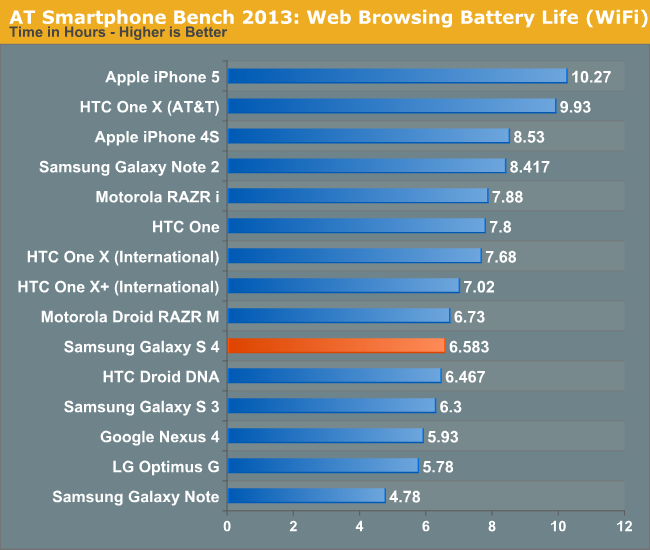
On WiFi the Galaxy S 4 falls behind the HTC One by an appreciable amount, however there's still an improvement in battery life compared to the Galaxy S 3. The Galaxy S 4's battery life isn't bad by any means, but do keep in mind that this is a large phone with a large display and a very powerful SoC. For much of the past year we've been talking about an increase in dynamic range in total platform power of high end smartphones and the Galaxy S 4 is no exception. Run it at full brightness or keep many cores running in their maximum performance states for a considerable period of time and you'll be greeted by a phone that's quickly in need of a power outlet.
As I mentioned earlier, we only have access to the Sprint version of the Galaxy S 4 at this point which unfortunately means that our 3G results aren't all that comparable to other devices here.

Even on Sprint, the Galaxy S 4 does surprisingly well.
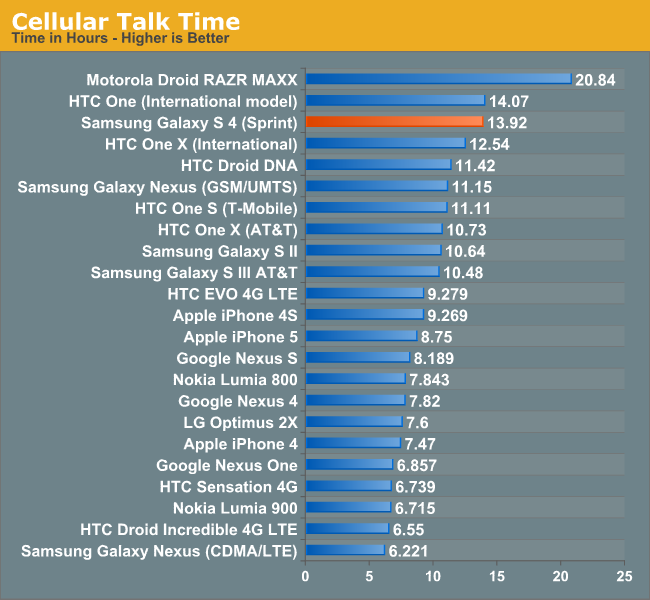
Talk time is excellent on the Galaxy S 4, with the phone delivering effectively the same battery life as the HTC One. Without having to power on that huge display, the Galaxy S 4 can last for a very long time on a single charge.
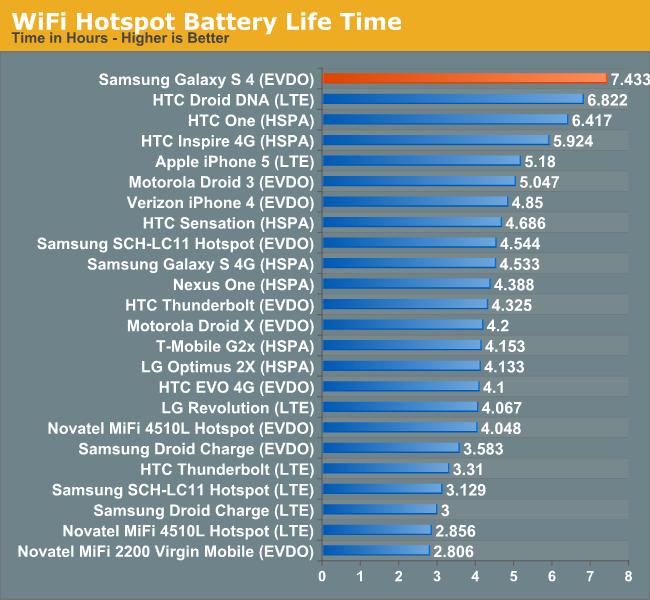
A combination of the Sprint network and the fact that the Galaxy S 4's display remains off during our hotspot test resulted in great battery life here as well. Again, this data isn't all that useful if you're not on Sprint but Samsung tells us we should be able to get our hands on an AT&T SGS4 in the not too distant future.
Charge Time
Samsung appears to implement Qualcomm's Quick Charge specification in the Galaxy S 4 and its bundled charger. I realize we haven't done a deep dive into what Quick Charge is and how it works, but I'll try to go through a quick explanation here. Most conventional chargers are linear, they take a fixed amount of input current (at 5V) and pass it along to the device being charged. The problem is that at deeply discharged states, the device's battery might be at a substantially lower voltage. A traditional linear charger won't change the current supplied based on the voltage of the battery being charged, and as a result can deliver sub-optimal charge times. When implemented, Qualcomm's Quick Charge technology can vary output current based on the voltage of the battery being charged, which results in less power being dissipated as heat and more being delivered to charging the battery itself. The table below helps illustrate the savings:
Quick Charge, at least in its currently available 1.0 specification, is still bound by the 5V limits of the USB BC 1.2 specification. The next revision of Quick Charge will enable higher voltage operation for even faster charge times.
| Qualcomm Quick Charge 1.0, Theoretical Example | ||||||
| Input Current @ Voltage | Input Power | Output Current @ Discharged Battery Voltage | Output Power | |||
| USB BC 1.2 - Linear Charger | 475mA @ 5V | 2.375W | 475mA @ 3V | 1.425W | ||
| Qualcomm Quick Charge 1.0 | 475mA @ 5V | 2.375W | 700mA @ 3V | 2.100W | ||
The non-linear nature of Quick Charge significantly shortens charge time, particularly in the very early stages of charging when the device's battery is presumably fully discharged. As the device's battery voltage increases, current delivery tapers off and the QC advantage is no longer as great as a standard USB BC 1.2 solution. The end result though is significantly improved charge times.
The graph below shows the benefits of using Samsung's own charger vs. a standard charger that implements the USB BC 1.2 specification. When used with the bundled charger, the Galaxy S 4 recharges much faster than HTC's One, despite using a larger battery. Obviously the Galaxy S 4 will charge with any USB charger, but the charge time will simply be longer. Samsung uses a voltage divider and signals the presence of their own charger by sending 1.2-1.3 V across the D+ / D- pins, this is similar to what Apple does with 2.0 or 2.8 V across the pins for various USB chargers they've shipped over the years. This signaling is essentially Samsung's proprietary tablet charging signaling which they've employed on the Galaxy Note 2 and now SGS4, in fact the two use the same exact charger, so it's worth tossing out your old ones and getting the appropriate one to take advantage of the faster charging.
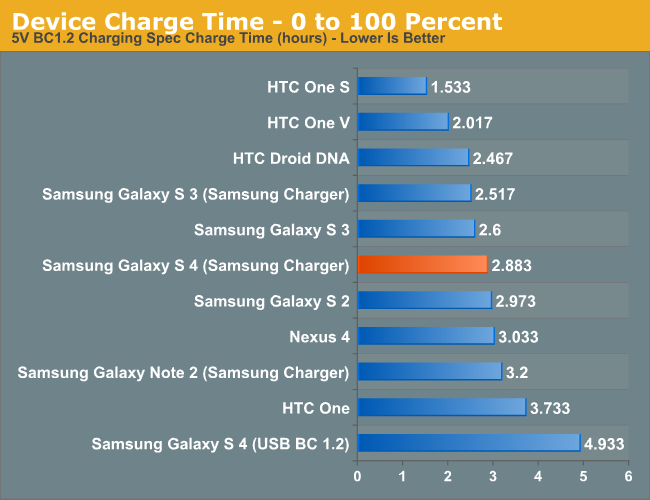


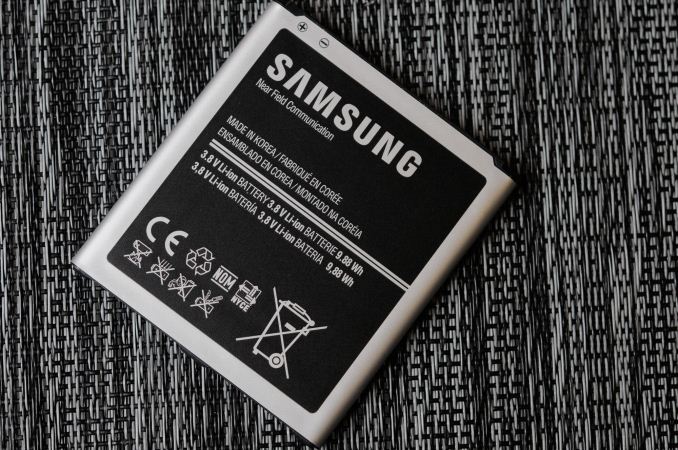








335 Comments
View All Comments
blue_urban_sky - Friday, April 26, 2013 - link
Not saying that. the ability of plastic to flex enables the little catches around the case to lock/unlock easily. to do that with alu you need a mechanical release which increases complexity. As a material plastic has advantages over glass/Alu and personally I don't mind it, not saying that I don't appreciate other materials just that as a functional cover it does its job well.CoryS - Friday, April 26, 2013 - link
The Droid X had a metal back plate, without a mechanical release. It also always came off in your pocket..zero2dash - Wednesday, April 24, 2013 - link
I'd rather have a plastic shell with a removable battery and a microSD slot than a metal frame with neither.But hey, whatever's most important to you...
xype - Thursday, April 25, 2013 - link
How often have you removed/changed your smartphone battery in the past? Just curious how often people who find the feature important use it (since I don’t know anyone who does so in real life).CoryS - Friday, April 26, 2013 - link
I did it daily with my Gnex. But, never have had the need with any other phone. The peace of mind is nice though. I think I have found I no longer need to swap batteries as much because I have changed my usage model to the battery life of the device...meaning I don't use my phone as much so it doesn't die.RiotSloth - Saturday, April 27, 2013 - link
I have an S3 with 2 batteries - I don't think I have ever swapped the battery out because I have a charger in my car and at work. Love dragging those batteries around and keeping them charged though.... and of course people buy phones because of how they look or what they are - saying that isn't so is just denial. Just because tech geeks don't doesn't mean others don't. How many people do you know who have phones they barely know how to use, but bought because they had heard its 'the one to get'?Androidtech - Sunday, April 28, 2013 - link
For all of you talking about removable batteries. I have both the Galaxy S3 and the HTC EVO 4g LTE. Out of these two phones the Galaxy S3 is my primary phone while the HTC Evo tags along and gets used randomly when I think about it. This is because I use my phone constantly and I stream podcast all day long at work to a bluetooth speaker. When I run one battery down I just pop in the other one and start charging the backup with the handy dandy Sammy battery/charger combo pack. Since my job is one that I am always on the move this is a great feature for me. I build oilfield pump packages and rebuild Industrial gearboxes like those used in ships and sugar mills.The ones in the ship turn the giant propellers and the ones in the sugar mills turn giant grinders. I also do welding and fabrication. So in a job like this I am always getting tools and moving from one part of a project to the next part or the next project. I am almost always standing up. This is much different than an office job where I could just plug my phone in at my desk. Even then why would I want a wire attached to my phone. Personally I would prefer a metal phone with a mechanically removable back maybe like the HTC Amaze 4g. Also as far as the case discussion goes There is no way I would use either of my phones with out a case and screen protector especially in my work environment. I like to keep my devices in top shape so when I am ready to get a new one next year I can sell it for top dollar or hand it over to my wife so I can use her upgrade again. That way I can say hey baby here is a nice phone and it still looks brand new ! She does not care about the latest and greatest or the fact that she is a year or two behind current technology and I always have the newest thing out since I am rotating 4 upgrades if you include my stepsons phone. You see there really is no reason to argue or try to decide which phone is better just get one HTC phone and one Samsung phone and enjoy the different qualities that each brings forth. Just be the one that pays for the famliy mobile Bill and you too can use everyones upgrade and stay on top of the cutting edge handset race. Works for me !Dug - Monday, April 29, 2013 - link
I don't know anyone or have seen anyone that changes their battery. In a company of 200 tech geeks I would think that this would be the majority and probably why HTC went away from it.TedKord - Thursday, May 2, 2013 - link
I'm a very heavy user. Hours of streaming Netflix, surfing endlessly. I can carry a second battery, and just swap out when the first runs down. I don't have to worry about carrying a plug,So to answer your question, I have at times swapped out my battery every day for months on end. Now, I'm rocking a 4500mah extended battery, and I always make it through the day.
I have a buddy at work who had an iPhone 4s, and it's battery had nearly died. He was getting a couple of hours max, but was out of warranty. He'd have killed for a swappable battery. Instead, after using my SGS3 and being impressed, he went out and got a Note 2, and left Apple all together. He hasn't regretted it a bit.
RiotSloth - Saturday, May 11, 2013 - link
Although you can change the battery in an iPhone fairly easily... or he could buy a mophie. I think everything has been said now about batteries - to some people it matters, to others it doesn't.